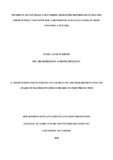| dc.description.abstract | Plant parasitic nematodes are a major threat to banana production since they result in reduction in yield, quality and longevity of banana orchards. This study was carried out to determine the diversity, abundance and occurrence of nematode destroying fungi in banana production farms with the goal of exploiting them in the control of plant parasitic nematodes. The influence of applying organic and inorganic soil amendments on nematode destroying fungi was also tested. The study area was stratified into three agro ecological zones namely UM3 (Low), UM2 (Mid) and UM 1 (Upper). Ten farms were randomly selected from each zone for soil sampling for the determination of diversity and abundance of nematode destroying fungi. One farm was randomly selected in each zone for soil amendment treatments. Nematode destroying fungi were isolated from the soil samples collected and identification of fungi done to species level. The diversity of nematode destroying fungi had a significant difference between zones; high zone had the most diversity and the uppermost numbers of fungi. The genera identified were, Arthrobotrys, Monacrosporium, Nematoctonus, Harposporium and Paecilomyces. Arthrobotrys were the most commonly isolated with an occurrence frequency of 45% followed by Harposporium with a frequency of 18% while the other three genera had occurrence frequencies of 9% each. The species identified were: A. dactyloides, Arthrobotrys oligospora, A. robusta, A. longispora, A. superba, Harposporium anguillulae, H. crassum, Meria coniospora, Monacrosporium cionopagum, Nematoctonus leiosporus, and Paecilomyces lilacinus. Trapping rate of the selected nematode destroying fungi after 96 hours was 76%; A. oligospora had trapped and destroyed 98 plant parasitic nematodes while M. cionopagum and D. phymatopaga had destroyed 88 and 76 plant parasitic nematodes, respectively within the same period. The means for nematode destroying fungi were significantly different for the different soil amendments with chicken manure having the highest number at 74 followed by cow manure, goat manure, control treatment and inorganic amendment with 71, 69, 54 and 39 isolates respectively. The number of isolated nematode destroying fungi changed over time from 89 isolates recovered pretreatment to
122 isolates after three months and dropped to 96 isolates after six months. The variation of nematode destroying fungi over time was significantly different confirming and influence of their presence by various soil amendments. The Arthrobotrys spp. is recommended as a potential candidate for field efficacy trials as it was the most diverse, had the highest killing rate, and its distribution in the banana plantations was enhanced by the organic amendments. | en_US |



